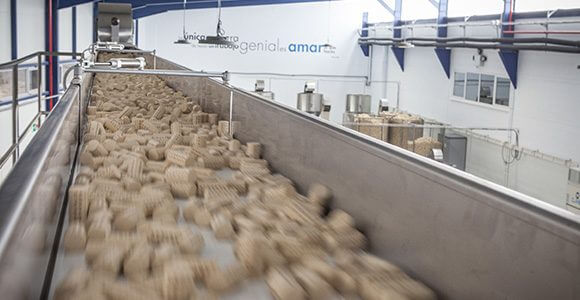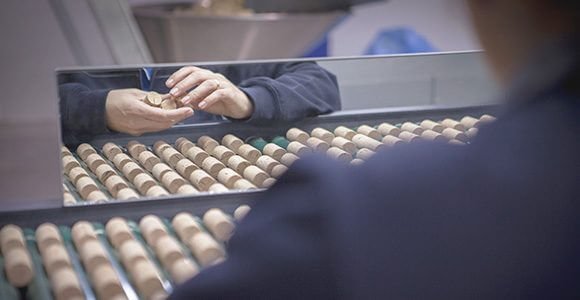Ebrocork receives the cork stoppers after they have overcome, in origin, the different validation controls required by Ebrocork, at the same time as the different phases of preparation and boiling of the bark and die cutting of the plates. Once at the Navarra plant, they go through rigorous internal controls.
OUR PROCESSES
With the rigor of who seeks perfection
CORKS STOPPERS
IN PLANT
Ebrocork receives the cork stoppers after they have overcome, in origin, the different validation controls required by Ebrocork, at the same time as the different phases of preparation and boiling of the bark and die cutting of the plates. Once at the Navarra plant, they go through rigorous internal and external controls on humidity, density, microbiological, oxidant residues, dust residues, capillarity, organochlorines, etc.
Once all the described controls have been completed, the cork stoppers rest in the warehouse until the different finishing processes are started before being delivered to the customers.
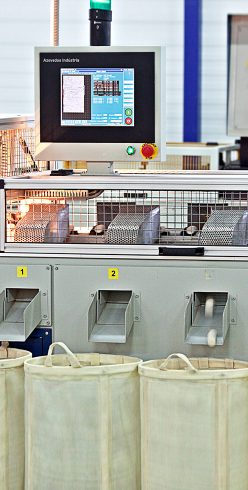
Before marking and delivering the cork stoppers to customers, two selections are made to them, already washed and stabilized:
- A first selection made with electronic optical processing machines, where the stoppers are classified according to the number and size of lenticels in both the body and the heads.
- A second visual selection, more meticulous made by skilled staff, is carried out in rotating tapes where the stoppers run, rejecting all the defective ones that could create a problem in the closing of the bottle. This process is followed for the elimination of broken stoppers, very porous or with major defects, which do not obey the quality that is being selected, achieving in this way always very homogeneous qualities.
It is part of the various processes to which the cork stopper is subjected to give it the ideal characteristics according to the virtues that will later be required.
The anticapilarity treatment consists in applying a polymeric coating to the surface of the stopper to prevent capillary fluid rise.
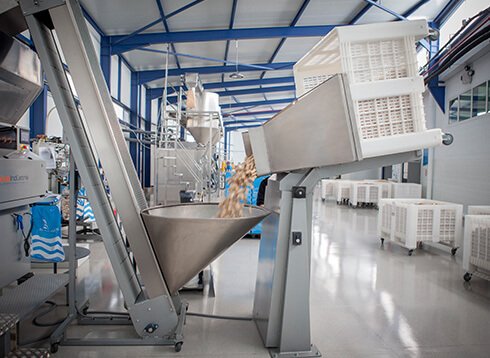
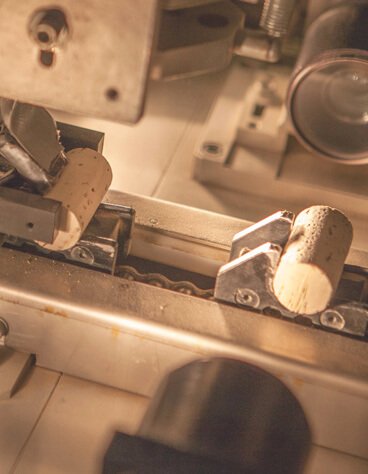
The print of the stopper can be in link or on fire.
When the customer require to have the heads of the stoppers printed, this process necessarily has to be on fire, for it Ebrocork has a system of fire printing both for the body and the heads, by resistances that achieve greater fidelity and accuracy of the image. It is the most accurate current technology in the cork stopper printing.
For the ink printing, food inks are used that respect the composition and organoleptic characteristics of the wine and that comply with the European Regulation for materials in contact with food.
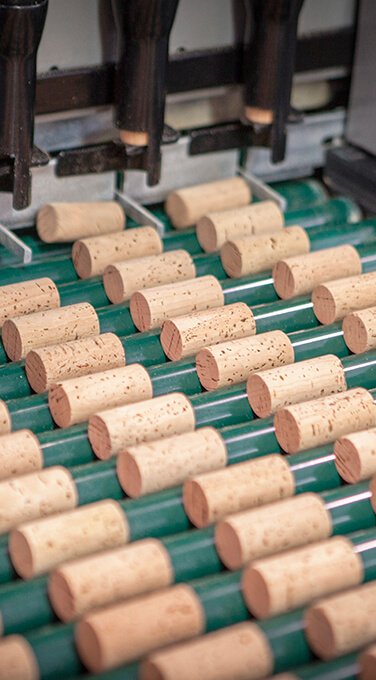
Last industrial processes carried out on the stoppers already manufactured, have as objective to apply surface treatments to lubricate the stopper and thus facilitate its compression in the jaws of the bottling machine and its introduction in the bottle, as well as its extraction after.
The objectives of the surface treatment are:
- Lubricate the surface of the stopper
- To facilitate the sliding of the stopper in the jaws of the bottling machine and the introduction in the neck of the bottle
- Facilitate the uncorking getting appropriate force extraction
- Improve the gas and liquid tightness
- A good surface treatment ensures that the stoppers are not permeable and do not show capillarity.
The products used are those recommended by the European Cork Confederation (CE-LIÈGE) and listed in the International Code of Tapping Practices: paraffin and silicone elastomers.

The BRC IoP Certification in grade “AA”, ISO 9001: 2015, the SYSTECODE PREMIUM certificate granted by Ce-Liège, and Sanitary Registry confirm the aptitude of a company to detect any non-conformity of the product. The Quality Management System derived from the commitment acquired with the Certification is transformed into inspections and tests throughout the entire manufacturing process until the product is sent to the customer.
The controls that are carried out can be classified into three types:
MECHANICAL METHODS
- Measurement of the dimensions, humidity and apparent density of the stopper
- Measurement of humidity
- Capillarity and tightness test
- Diametrical cork stopper recovery
- Extraction force
- Powdered content of cork stoppers (colmated)
These tests are carried out in accordance with Standard UNE 56921, 56922, 56924, and 56926.
MICROBIOLOGICAL METHODS
Its objective is the count of mesophilic aerobic bacteria, filamentous fungi and yeasts present on the surface of entire stoppers, treated or untreated, that is, both raw material and finished product. Depending on the microorganism targeted by the count, different culture means are used, Triptone Soya Agar and Rosa Bengala / Saboraud respectively, in accordance with UNE Standard 56921, 56922, 56924, and 56926.
CHEMICAL METHODS
- Oxidant residue test, to analyze the wash residues of different oxidizing compounds using a reflectometric technique.
- Analysis of organochlorine compounds belonging to the family of chlorophenols and chloroanisoles by gas chromatography
SELECTION OF STOPPERS

Before marking and serving the corks to customers, two selections are made from them, already washed and stabilized:
- A first selection with electronic optical processing machines , where the caps are classified according to the number and size of lenticels both in the body and in the heads of the cap.
- A second visual selection , more meticulous, made by experienced personnel, is carried out on rotating belts where the caps run, rejecting all the defective ones that could create a problem in the closure of the bottle. This process is followed to eliminate broken caps, very porous or with major defects, which do not obey the quality that is being selected, thus achieving very homogeneous qualities at all times .
ANTICAPILARITY COATING
It is part of the various processes to which the cork stopper is subjected to give it the ideal characteristics according to the virtues that will later be required.
The anticapilarity treatment consists in applying a polymeric coating to the surface of the stopper to prevent capillary fluid rise.

PRINTING

The print of the stopper can be in link or on fire.
When the customer require to have the heads of the stoppers printed, this process necessarily has to be on fire, for it Ebrocork has a system of fire printing both for the body and the heads, by resistances that achieve greater fidelity and accuracy of the image. It is the most accurate current technology in the cork stopper printing.
For the ink printing, food inks are used that respect the composition and organoleptic characteristics of the wine and that comply with the European Regulation for materials in contact with food.
SURFACE TREATMENT

Last industrial processes carried out on the stoppers already manufactured, have as objective to apply surface treatments to lubricate the stopper and thus facilitate its compression in the jaws of the bottling machine and its introduction in the bottle, as well as its extraction after.
The objectives of the surface treatment are:
- Lubricate the surface of the stopper
- To facilitate the sliding of the stopper in the jaws of the bottling machine and the introduction in the neck of the bottle
- Facilitate the uncorking getting appropriate force extraction
- Improve the gas and liquid tightness
- A good surface treatment ensures that the stoppers are not permeable and do not show capillarity.
The products used are those recommended by the European Cork Confederation (CE-LIÈGE) and listed in the International Code of Tapping Practices: paraffin and silicone elastomers.
CONTROL OF FINISHED PRODUCT

The BRC IoP Certification in grade “AA”, ISO 9001: 2015, the SYSTECODE PREMIUM certificate granted by Ce-Liège, and Sanitary Registry confirm the aptitude of a company to detect any non-conformity of the product. The Quality Management System derived from the commitment acquired with the Certification is transformed into inspections and tests throughout the entire manufacturing process until the product is sent to the customer.
The controls that are carried out can be classified into three types:
MECHANICAL METHODS
- Measurement of the dimensions, humidity and apparent density of the stopper
- Measurement of humidity
- Capillarity and tightness test
- Diametrical cork stopper recovery
- Extraction force
- Powdered content of cork stoppers (colmated)
These tests are carried out in accordance with Standard UNE 56921, 56922, 56924, and 56926.
MICROBIOLOGICAL METHODS
Its objective is the count of mesophilic aerobic bacteria, filamentous fungi and yeasts present on the surface of entire stoppers, treated or untreated, that is, both raw material and finished product. Depending on the microorganism targeted by the count, different culture means are used, Triptone Soya Agar and Rosa Bengala / Saboraud respectively, in accordance with UNE Standard 56921, 56922, 56924, and 56926.
CHEMICAL METHODS
- Oxidant residue test, to analyze the wash residues of different oxidizing compounds using a reflectometric technique.
- Analysis of organochlorine compounds belonging to the family of chlorophenols and chloroanisoles by gas chromatography

